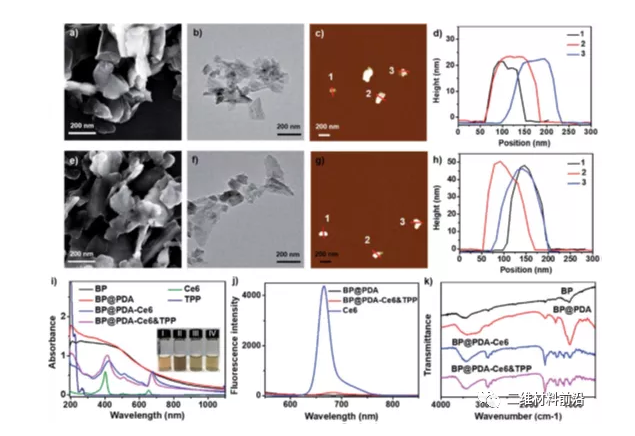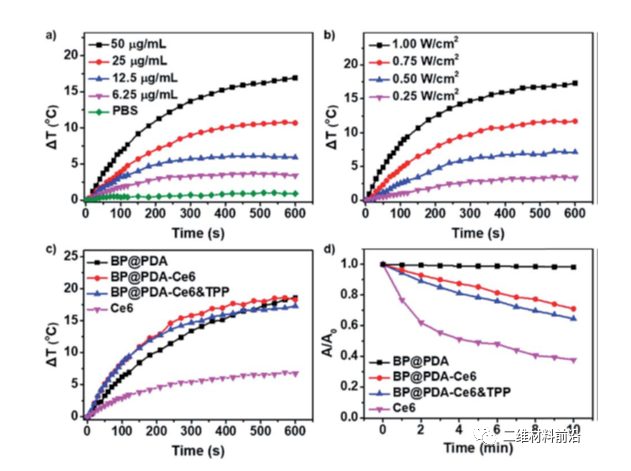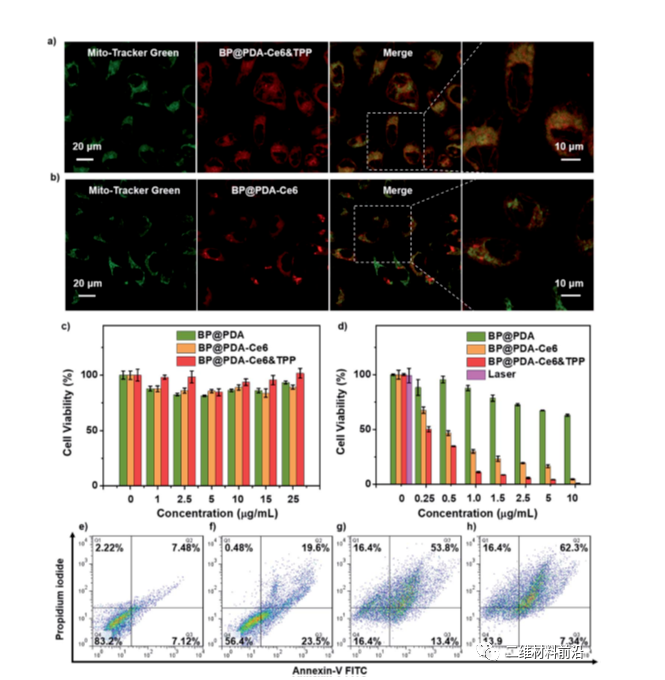
hotline:
17715390137
Tel/Wechat:
18101240246 (Technology)
0512-68565571
Email:mxenes@163.com (Sales Engineer)bkxc.bonnie@gmail.com
Scan the code to follow or search the official account on WeChat:
2D Materials Fronrier After paying attention,
click on the lower right corner to contact us,
Enter enterprise WeChat.
Professional Services Online

Nanomaterials phototherapy includes photothermal therapy (PTT) and photodynamic therapy (PDT). PTT uses light energy absorbers to convert light energy into heat energy to cause cell death. PDT uses photosensitizer (PS) to generate reactive oxygen species (ROS) under light, causing oxidative stress and cell membrane damage, and ultimately killing cancer cells.
Since 2015, black phosphorus (BP)-based nanomaterials have become a new type of biomedical inorganic materials due to their excellent biocompatibility, biodegradability and biosafety. Although progress has been made in black phosphorous-based phototherapy in recent years, its therapeutic effect still faces challenges.
How to generate heat or ROS at the target site to induce cytotoxicity without damaging the surrounding biological tissues. On the basis of functionalized black phosphorous nanosheets (BP-NSs), the research group of Professor Xiaochen Dong from the Advanced Materials Research Institute of Nanjing University of Technology has developed an imaging-guided mitochondrial targeted photothermal/photodynamic nanosystem.
The paper was published on "Chemical Science" with the title "Functional black phosphorus nanosheets for mitochondria-targeting photothermal/photodynamic synergistic cancer therapy".
Organelle-targeted phototherapy based on nanomaterials is considered to be a promising tumor treatment method due to its advantages of minimal invasiveness, good selectivity, high treatment efficiency, small side effects, and fewer complications.

Figure 1 Schematic diagram of material preparation and tumor phototherapy in this work
In this work, BP-NSs was first coated with polydopamine (PDA), and then covalently reacted with chlorin e6 (Ce6) and triphenylphosphine (TPP) through the carbodiimide reaction between amino and carboxyl groups Connected to construct BP@PDA-Ce6&TPP-NSs nanocomposite.
In this nano-system, PDA forms a conformal layer on BP NSs, which can improve its light-to-heat conversion efficiency, provide amino anchor points for further functionalization, and enhance the stability of BP NSs. Ce6 has good ROS generation ability and near infrared fluorescence, which can be used for PDT and fluorescence imaging. And TPP can provide mitochondrial targeting ability through membrane potential.

Figure 2 Characterization spectra of BP NSs, BP@PDA NSs, BP@PDA–Ce6 NSs and BP@PDA–Ce6&TPP-NSs
The author of the paper first tested the photothermal performance of the nanosystem: under the irradiation of 660 nm laser, BP@PDA increased the photothermal conversion efficiency (from 26.6% to 33.2%) compared with the BP-NSs not modified by PDA.
Due to the strong absorption of BP@PDA in the near-infrared region and the higher ROS generation efficiency of Ce6, BP@PDA-Ce6 and BP@PDA-Ce6&TPP-NSs all show good ROS generation ability under 660nm laser irradiation.

Figure 3 Photothermal characteristics of BP@PDA-NSs, BP@PDA–Ce6-NSs and BP@PDA-Ce6&TPP-NSs in aqueous solution
Subsequently, by tracking the Ce6 fluorescence signal by confocal imaging, the author studied the mitochondrial targeting ability of BP@PDA-Ce6&TPP-NSs. Incubating HeLa cells with BP@PDA-Ce6&TPP-NSs, the fluorescence images of the two channels of HeLa cells overlap very well, indicating that BP@PDA-Ce6&TPP-NSs showed selective aggregation in mitochondria.
Thanks to the endogenous near-infrared fluorescence of Ce6 and the high absorbance of BP@PDA, the author of the paper used in vivo fluorescence and infrared thermal imaging technology to study the effect of imaging-guided in vivo PDT/PTT treatment. The results proved that the tumors of the mice irradiated with laser BP@PDA-Ce6&TPP-NSs gradually shrank, leaving black scabs, and then they were completely cured within 14 days. It proved that BP@PDA-Ce6&TPP-NSs cooperated with PTT/PTT through mitochondrial targeting. PDT exhibits excellent tumor ablation effects.

Figure 4 Confocal fluorescence images of different nanosystems (a-b), cell viability experiments (c-d), flow cytometry analysis (e-h)

Figure 5 In vivo photothermal/photodynamic synergistic tumor therapy of different nanosystems
This work achieved real-time monitoring of photothermal and photodynamic combined therapy through fluorescence imaging in vivo, and achieved excellent results in inhibiting tumor growth. This study proposes a new nano-biotherapeutic agent targeting mitochondria, which opens up a new horizon for biomedicine.
The first author of the paper is Xiaoyan Yang from Nanjing University of Technology, and the corresponding authors are Dr. Lu Min, Dr. Song Xuejiao and Professor Dong Xiaochen from Nanjing University of Technology. Nanjing University of Technology is the first to complete the paper.
[Article link] Functional black phosphorus nanosheets for mitochondria-targeting photothermal/photodynamic synergistic cancer therapyXiaoyan Yang, Dongya Wang, Jiawei Zhu, Lei Xue, Changjin Ou, Wenjun Wang, Min Lu, Xuejiao Song, Xiaochen DongChemical Science, 2019-02-21DOI : 10.1039/c8sc04844d
Scan or press and hold the QR code, after recognition, you will go directly to the original page
This paper is only used for academic exchange and has no commercial purpose. Copyright belongs to Royal Society of Chemistry 2020
To reprint, please contact the editor’s mailbox and indicate the source in a prominent position
If you accidentally infringe, please contact the editor to delete

| Reminder: Beijing Beike New Material Technology Co., Ltd. supplies products only for scientific research, not for humans |
| All rights reserved © 2019 beijing beike new material Technology Co., Ltd 京ICP备16054715-2号 |